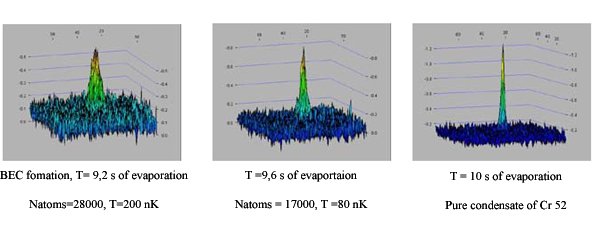Chromium Bose Einstein Condensate


On November 17, 2007, we got our first condensate of dipolar chromium atoms 52Cr. Our set-up to create the condensate from cold atoms of chromium is an all optical evaporation method. We trap several million metastable atoms of chromium in an optical trap formed in the focus of an infra-red horizontal beam of high intensity. We accumulate 5S2 metastable atoms into this trap in presence of the MOT laser beams. Then we switch off the beams and the MOT gradient, we transfer the atoms in the ground state, we spin polarize the atoms in the state of lowest energy, and then we superimpose gradually a vertical IR beam to the horizontal beam, so that we create a "dimple" pontential at the beam intersection.
Finally, it is in this "dimple" that we perform evaporative cooling by lowering the power of the optical trap. The experimental proof for the obtention of a condensate fraction are, as for other condensates, the emergence of a very fine peak at the center of a thermal distribution for a critical value of the final temperature (the bimodal structure appears for a temperature of about 150 nK). We observed as well an anisotropic expansion after switching off the trap. We obtain on a regular basis a pure condensate of about 10000 atoms in a 18 s long sequence.
The field of quantum dipolar gases offers many opportunities for research that we will explore in the coming years with a particularly strong interest for the transfer of quantum dipolar gases into optical lattices (1D, 2D and 3D) and for the realization of a Fermi sea with the fermionic isotope 53Cr that our experimental setup allow to prepare at the same time as the bosonic isotope.
